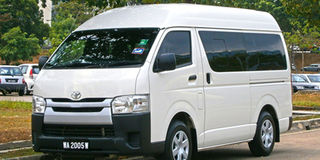Toyota Hiace or Nissan Urvan, which would be the best taxi?

Toyota and Nissan have differing philosophies when it comes to commuter vans, and this is reflected in the different layouts of each. NET PHOTOS
If one would like to venture into the transport business and is considering buying, say an 11-seater shuttle that will cover a distance of approximately 500 kilometres daily on a good and smooth road, there are a couple of options to choose from.
One of these is the Toyota Hiace van (box) and the newly introduced Nissan NV350. Both vehicles (diesel and petrol versions) are almost similar in look, size and capacity.
Before you make your choice, ask whether between the two engine variants, which one is more reliable as far as power, efficiency and reliability are concerned, which is better considering the number of kilometres to be covered and the task the vehicle will undertake and routine servicing costs of the petrol and the diesel version?
Consumption
The Toyota 2KD engine is diesel-powered, turbocharged, not petrol. Power and efficiency favours the diesel engines in both brands since they are both turbocharged and pack more inches in their trousers compared to the petrol engines.
The YD25DDTi High Power Nissan engine makes about 190hp and 450Nm. The 1KD-FTV Toyota engine does between 170hp/352Nm and 190hp/420Nm, so it may seem Toyota loses this battle on paper, but I have seen these things in action, and unless they are secretly tuned before being put into service, they are not to be trifled with.
The 2KD will go unlisted for now because its outputs are inferior to the aforementioned pair, which are more evenly matched.

Both these engines are roughly 20 years old, but they have hung around for so long with only minor updates because they are extremely popular with users, especially those in the market for a double-cab pickup or an SUV, but they are not without their weaknesses.
Engine setbacks
The YD25 has been known to suffer injector problems and ECU failures while serving duty in the D40 Navara. Therefore, do not be surprised to see these weaknesses transferred to the NV350.
There is also a risk of premature timing chain failure, which are words nobody ever wants to hear about their engine.
Service
Inspections are strongly recommended at the 100,000km mark and then every 40,000km after that. There have to be inspections because these timing chains operate quietly even when worn out or stretched so when it goes bang, you will never hear it coming. Like its ZD30 stable mate, the EGR in the YD25 is also a source of grief, which causes excessive smoking, and the EGR cooler could cause a coolant leak via corroded or split flanges.
The 1KD is rattly from a cold start. This may or may not be an issue, a quandary solvable once the engine heats up. If it goes quiet, then you’re good. If it keeps rattling, then you have faulty injectors. The fuel pump is also a potential candidate for going on the fritz.
Beyond this there does not seem to be much else to cause alarm, but as with all turbo-diesel engines from before, say, 2010, good care must be taken to prevent turbo failure. This mostly involves warm-up on start-up and cool-down before shut-down, more so if some heavy-duty work is involved in between those two points.
Diesel wins
The diesel engine gives better gas mileage (I see the oxymoron there, but roll with me) combined with diesel fuel being cheaper per litre than petrol and it develops comparatively more torque, which is something you will need when toting a payload, human or otherwise.
Service costs
Routine servicing costs are what they are. I have never had to service any of these engines, and prices of parts, especially filters, vary by brand and location, as do labour charges, so you will understand when I tell you that I do not have solid figures for this.
If you seem to head in the opposite direction to that a rational PSV operator would take, the 2.0 petrol is not bad in and of itself, but you will be thrashing it at full throttle especially on hilly sections just to get any semblance of motion out of it. This will hurt engine life and fuel economy.
Despite first coming across the NV350 six years ago, interaction has been sparse and it has not hung around here long enough for users to draw meaningful conclusions about its service life.
It has yet to prove itself, but in doing that, it has to deal with the crippling effect of being saddled with the YD25 High Power, which did not fare too well in the Navara D40 historically.
The NV350 may undergo the same evolution that the HiAce H200 did in the early days of KD engine family use in PSVs, lack of knowledge on direct injection and turbocharging led to a lot of premature failures to the point where many operators were swapping out the KD engine and installing much older 3L and 5L engines, which they believed were more robust and had longer life, besides being cheaper to maintain.
Adapted from Daily Nation




